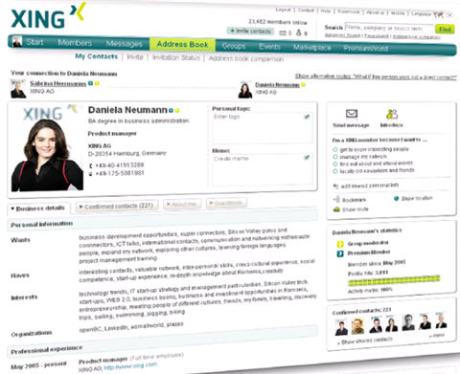Crossing or Xing?

Xing profile
Xing is a German based business network that began in 2004. The network is structured for business and job purpose. The registration is free but practically all features can be used if a premium member is activated. All thou it is a business platform you don’t receive a receipt of payment.
Xing has 7 million registrations, Around 4 million are active users, others are considered sleepy due to its very passive activity. Xing has bought Neurona a Spanish business network in 2008. Hereby it has broken its German frontiers to enter a European playground of social networks. Numbers shows that 30% of its users are German ( or German speakers) another 15 to 20 % are Spanish users, the rest of the users are mostly European with the UK and Italy in front. To compare it with Linkedin, Linkedin has arrived to (March 2009) to 35 million users on which 60 % of the users in the American continent and growing number in India.
The other competitors of Xing is French based Viadeo.
On the free version you can customize your profile and add your known contacts to your profile. You can search for a job and you can be contacted by premium members.
If you register for the first time, you will have 6 months free premium memberships which provides you by far more features. The premium membership allows you to view and contact (indefinitely) any profile in the network. On Linkedin Premium it allows you to view profiles inside the whole network but the contacts are numbered by 5 a month. The premium membership provides its members to search and contact any profile, create and organize groups inside Xing, search and candidate to jobs or add jobs for a small fee.
The strength of Xing is its Multilanguage platform (16 languages including Chinese).
I have used Xing for talentscouting purposes and found it a very interesting application, also because you could use this application directly with your mobile, both downloading contacts as uploading. Linkedin premium costs 3 times more per month than Xing and it does allow you to sent only 5 mails per month, you can cumulate but what are 5 mails if you need to contact hundreds of people a month !? Xing allows you to contact indefinitely. Linkedin wins only by the numbers of registration. Xing has also another disadvantage, it has a lack on workspace application, which Linkedin has provided with a series of application, such as Box.net, Huddle, WordPress, Slideshare, etc.
This gives the profile the opportunity to use this platform as a workspace and stimulates crowdsourcing.
The future plans of Xing are new local marketing campaigns in order to promote this interesting business tool.
Facebook, the new social revolution 2
You can use Facebook for different purposes, besides finding your old classmates you can use Facebook for business purposes as well. Different online job sites are all ready connected to Facebook to post and redirect its users to find jobs. Careerbuilders like as many others use facebook as a job interface.
Indeed those career sites know the power of social networking and its exponential growth of population around the globe. more than 150 million people connected to Facebook are today and future talent potential. Myself working for one of the biggest industrial companies in Italy as a talent scouter use Facebook to find talents.
How to find a job:
You can attach one or more jobsites as an application to your profile. You have to type the keyword jobs than click on application on the results menu.
A menu appears with a wide range (more than 500) of job applications:

The list is ranked based on the activity and the number of clicks on the feature.
This list provides you with a brief description of the application and its purpose.
How to apply online:
First choose the site that matches your needs and click to view application.
n.b. Not all applications can be added to your profile.
When you click on view you have an overview of latest feeds of the jobsite.
You can also become a fan of the application and therefore contribute to its popularity.
The page for application is purely branding the trademark.

These applications are developed by the careersites itself. These companies pay facebook for the visibility. Facebook developers provide them with page building tools in order to create a jobsearching tool for every profile. Depending on the application you can only search for a job if you add as an application to your profile.
The application page looks exactly as a group page or a fan page. Users can join the application such as fans or groups. You can even rate the application. Add discussions, and comment the application on “Reviews” or on the “Wall” .
The jobprovider is presented with a glossary for the page.
Once you have add the application to your profile, you will find an icon of the application under your page next to applications, or when you click on applications, scroll up on the menu.
 on this image you can see two job on this image you can see two job on this image you can see two job on this image you can see two job
on this image you can see two job on this image you can see two job on this image you can see two job on this image you can see two job
application, one by careerbuilders and the other by jobs/indeed.
Every application is used in a different way due to the fact that it has been developed independently by the jobsite itself.
Also beneath on the menu bar you can find the icon of the job application.
Once you add the application you can start search jobs !!
How can I do Business with Facebook?
Before I talk about business, let me give you a tip first. Web 2.0 is about sharing, collaborate and interact with everyone into ecosystems with common goals and opportunity. Folksonomy are providing rich contents for everyone to share this knowledge, while contributing to development of science, business, entertainment and art. This means that whatever you want develop, you will have to be involve inside one or more groups with common interest. If you are a musician than you will be tend to joint a group of musicians that share the same passion you have for a particular instrument or music style, if you are a chemical engineer than you will rather go to a group that gather other chemical engineers like you, all with the purpose of sharing knowledge, perhaps ideas and new developments.
Facebook is not yet prepared to a more professional use of the site because it does not contain a search option for professional use. The only way you can gather business networks is to create groups which people can identify, you can either create a group where people will not be joining the group without the administration permission or a free joining group.
Besides groups you can add a fan page of your brand, such as coca cola who add a fanspace on Facebook, it has more than 2.5 millions of fans !!!
this will boost the trademark but also its employer branding noticing its creative, young and innovative approach.
Your guide through the social networking jungle

online social networks
Since 2004 after Tim O’reilly speech about the web 2.0 (the interactive www) never before was the use of online social networking so powerful. On its early days, with classmates.com created in 1995 with the scope to reunited your former schoolmates. Discretely other became to emerge from the web jungle. The first came with the purpose to find your lovemate or your ex-schoolmate others became business related or even knowledge sharing social networks that enabled scientists around the world to connect.
Today there are hundreds of them, I’ll get at least every day one or two invitations from someone I know or through my network to get connected into a new social networking site. Whether you are a scientist or a businessman or a recruiter, or a student or just a person looking for love or friendship, you need to know which social network is suitable for you, therefore I created this blog for you to comment as a guide through the social networking jungle. have fun……
Fundamentally you can divide social networks into two different types, the private or internal communities and the open communities.
Internal communities are platforms that have a selected number of connections such as a smallworld for example. In Smallworld you can only be registred if you have been invited by someone. Another example of private communities are specific communites with common interest such as Great cook community. Yet another example are intranet platforms such as a company community platform based on a online networking community of colleages of the same company. A company based in Italy provides internal platforms or entreprise 2.0 to companies, yooplus. It enables a company that has facilities around the world to be connected under an online work space. This online platforms facilitates the information traffic. When you put a newsfeed of the sector into the bullitin board, everyone will be able to see it instandly. Sharing documents is possible and the use of numerous applications such as API’s simplifies the intermengle of data traffic both inside as outside the platform.
External or open communities: are social networks where everyone has the possibility to join. In most of this communities, both users must confirm that they are friends before they are linked. If Peter lists Vanessa as a friend, then Vanessa must have to approve Peter’s friend request. Some communities allow to view friends of your friends till the thirth degree of connection. Others such as facebook allows you to see only the name of the profile with a picture.
-
Archives
- May 2009 (1)
- April 2009 (4)
- March 2009 (4)
- February 2009 (5)
- January 2009 (4)
-
Categories
-
RSS
Entries RSS
Comments RSS

